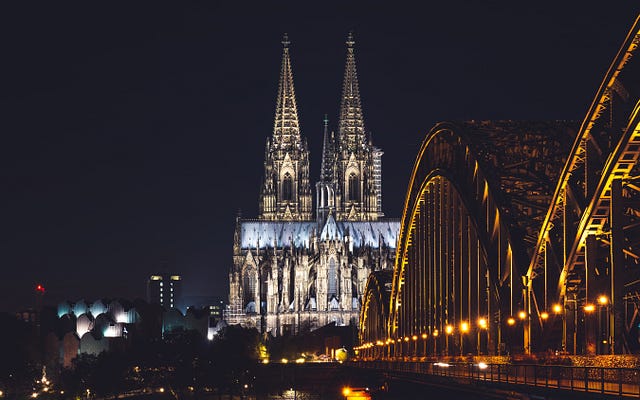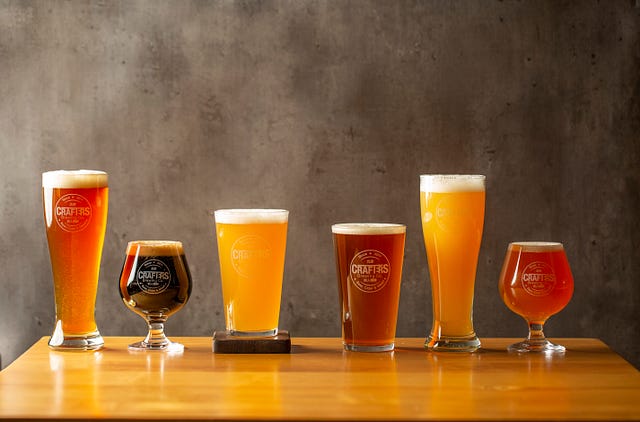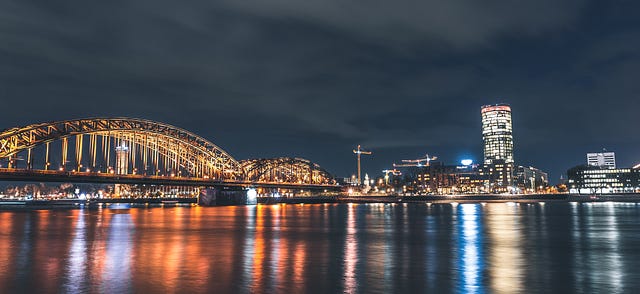Hint: It’s not Berlin.
With a local friend, I visited three of the country’s largest cities. Hamburg, Düsseldorf, and Cologne.
Our experience in the latter was shorter than we would have liked, but still full of useful information about the city. So, here we go. . .

After rising early to a traditional home-cooked German breakfast in Monja’s home, we met her friends in Cologne.
Cologne (Köln) has an interesting history. It’s a much more lively city than it has been in the past 75 years.
About Cologne, Germany. . .
Often known as Germany’s cultural hub, the 2,000-year-old city is the fourth most populated in the country. Roughly one million inhabitants call it home. Though, the metro area contains around 3.6 million.
It is located along the Rhine River, north of Düsseldorf. In the Middle Ages, it thrived on one of the most important trade routes connecting Eastern and Western Europe.
Later, about 95% of the city’s population was lost in the Second World War. It was one of the most heavily bombed cities during the war. As such, many lives were lost and others packed up and moved.
Many medieval architectural structures were lost and never rebuilt after the war. In fact, only three of the original 12 medieval city gates survived.
As of 2010, the city’s population finally regained pre-WWII numbers at one million people.
First Impressions. . .
The first thing I saw as I exited the train station was the Cathedral of Cologne. It’s the third tallest spire in the world.
Even on a gloomy day, it’s the most impressive cathedral I’ve seen in Europe. Every detail of the architecture is so well-done. It is hard to imagine the time and skill it must have taken to complete it.
As with most historic structures in Europe, the cathedral was under a lot of construction. Construction always takes away from the visible appeal.
Regardless, I took my, time as afternoon mist fell, to be in awe of what was in front of me. One of the best parts about it is that it is right outside of Cologne’s main train station. A perfect surprise for backpackers who may be jumping from city to city with a time restriction.
Breweries to dodge the rain
After a while, the rain started to dampen the mood. We toured the inside of the cathedral amongst hundreds of gawking tourists.
Tired of sheltering from the rain, we changed our plans and decided to do a brewery hop. First, the well-known beer of Cologne, Kolsch. This after having toured Altbier in Düsseldorf the night before.
If I have to choose, Altbier provided a better experience. Not only because the beer was better, but the brewery’s atmosphere was also better.

No more love on Hohenzollern Bridge
After a few hours and a few too many beers, the rain had still not slowed so we decided to see as much of what we could in the rain.
We walked across the Hohenzollern Bridge. Every bridge in Europe has become a “love lock bridge”. With hundreds of padlocks signifying a couple’s eternal love. . . Oh, spare me.
This bridge caught my attention for a different reason, though.
The padlocks on the Hohenzollern Bridge are only about half what was locked to it before. It is said the bridge’s weight from the growing number of padlocks was becoming an unforeseen safety issue.
The architects were unsure if the Hohenzollern Bridge could withstand the constant weight. So, the city removed half the locks and banned “locking your love” to the bridge for good.
That’s a win for the lonely people!
The almighty Döner kebab
We walked past the University of Cologne. It’s one of the largest and oldest universities on the continent. But the rain had not let up and the weather was taking its toll on us. It was time I tried my first döner kebab.
Kebabs are offered all throughout Europe. However, I saved my döner virginity for Germany. Germans are known for good kebabs.

A döner kebab reminds me of a Greek gyro. It’s filled with either lamb or chicken. Roasted vertically on a rotating stick. And shaved from the roaster onto pita bread upon ordering.
An assortment of vegetables and some of the best sauce you can imagine also comes with the sandwich-like food.
Before arriving in Europe, I was told a döner kebab from Germany was mandatory. I must say, it didn’t disappoint. You have to try one.
More attractions, restaurants, and bars to see in Cologne:
Museum Ludwig — 20th Century art museum featuring works from Picasso
Das Ding — bar/Party district strictly for those with valid student ID (a lot of good food joints, too)
MTC — rock disco with many live performances
Grüngürtel — great picnic spot and perfect for spending time like a local
River Cruise — infamous Rhine River cruises with knowledgeable English-speaking guides

Cologne is a great stop for anyone traveling between East and West Germany. It is much less touristy than the likes of Berlin or Munich. For those who want the true, authentic side of Germany.
Join my newsletter for more helpful insights & exclusive content.
If you found this article engaging, please hit the clapper button to help me out!
Read More:
4 Ways to Grow Into a Real Traveler
The travel that you won’t find on an Instagram feed.medium.com